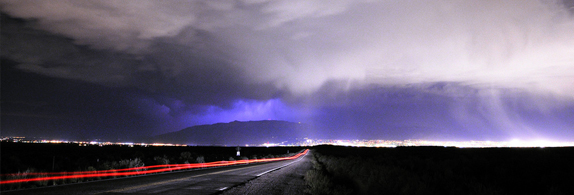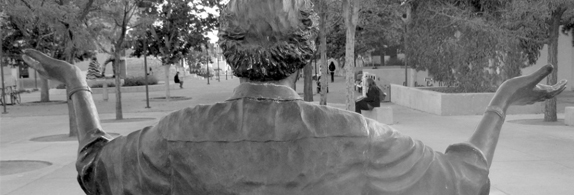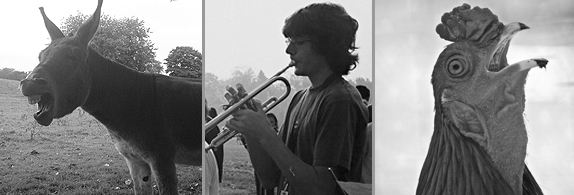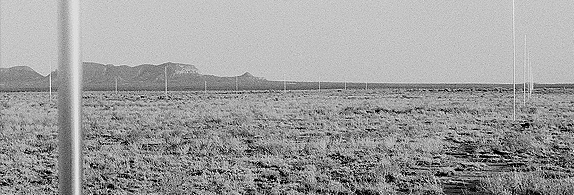A New Mexico Hurricane

I guess that’s the way it’s going to be from now on, a kind of hurricane roulette. The storm that broke on the Middle Rio Grande Valley a week ago Friday evening was the worst I’ve experienced in 55 years here. And I’ve been in some doozies. But the severity of this storm was unprecedented.
This one had winds up to 90 miles an hour or more. It was mythological. The trees in our garden were dancing madly and wouldn’t stop. I thought they’d snap from exhaustion. I was worried we could lose our roof.
It was a hurricane, alright, but a New Mexico hurricane, thank heavens. It lasted less than an hour, and then it was gone. Climatologists say it was a confluence of storms from all four directions with the worst winds in many decades.
I’m left wondering what’s in store for us ahead, especially since a freak storm dropped two feet of hail on Santa Rosa earlier in the summer.
We know that raising the planet’s temperature, even by one degree globally, puts a tremendous amount of new energy into climate systems. The general rule, as far as I can tell, is that while local weather patterns generally stay the same, they get supercharged, and more intractable and extreme. Dry places become drier. Monsoon seasons can become filled with maelstroms.
I’ve seen heavy flooding in Albuquerque before Cochiti Dam became operational in 1973. North Fourth and much of the South Valley were flooded to some degree every year. Storms are often rough here. I remember one where the wind was blowing so hard the rain came at you horizontally. And there’s nothing quite as flabbergasting as a flash flood moving toward you like a wall of water in an arroyo, or on a street where an arroyo used to be.
But this one last Friday was different. The ferocity was terrifying. The sound fantastic. One moment it was still and then in the blink of an eye a wind took hold that toppled trees in Tiguex Park near Old Town, and in numerous other city parks including Hyder, Roosevelt, and Kit Carson. Two big conifers on UNM’s central campus near the anthropology building were blown down leaving gaping spaces. There were similar tales up and down the Valley. Our cat got it right. This storm made you want to run and hide.
But that’s what our weather has become. At the Flying Star on Rio Grande, people were afraid to sit next to the big windows because the rain was hitting them so hard. Some said you couldn’t see the parking lot right outside. Others, though, said there was a carnival atmosphere inside, people safe but scared and excited at this amazing event.
Our full-leafed elms and cottonwoods made it through, and some big dead catalpas down the street made it through, too, without crashing on the street. The ditches had two blow-downs where we walk. One was a big dead elm that toppled over like Goliath. The other was a limb as big a tree that was just ripped right off by the wind.
I wonder if we’ll see hurricane roulette played out every year, with the winds continuing to increase. I’m pretty sure my roof would be no match for 100 to 110 mile an hour blast. But maybe it won’t happen for years, or maybe we’ll get hit next week.
Where the storms land, nobody knows. All I’m sure of is how happy the garden is with all that water. And those enormous rainbows – they celebrate our relief and gratitude as magically as anyone could imagine. In supernatural storms, the heavens open up, it seems, for both the deluge and the dazzling bridge to hope.
Katherine Simons

One of the most beloved professors ever at the University of New Mexico, the late Katherine Simons taught generations of students – me included – how to read and how to study. A scholar of Elizabethan literature, Katherine showed her students how curiosity can make the past come alive, how, in fact, it can bring anything to life.
Curiosity is the magic elixir that protects us from suffering the yawning hollows of boredom.
We learn from teachers like Katherine mostly by example. She modeled, if you will, the thrilling satisfaction of finding things out for yourself .
Katherine would come to class with one of her many black notebooks filled with facts and insights –Queen Elizabeth’s favorite foods, how her courtiers kept their hair combed, the kind of school room Shakespeare learned his lessons in, how many boars it took to feed a guests at a royal shindig, not to mention the endless source material she gathered for the Bard’s plays and sonnets. We learned that “Gossamers” were spiderwebs, that “dear hap” meant good fortune, that “heartless” to Elizabethans meant “spiritless” and cowardly, that “Skains-mates” meant “conjectures,” and that “vanity” was synonymous with earthly delights.
We were in awe of those notebooks. We wanted to make some for ourselves and she taught us how. Any question you might have, any question about anything, write it down and then look it up, and keep on looking until you have the answer. Life is full of questions, they never end. Katherine knew that Socrates was right. It’s owning up to our ignorance that gives us any chance at all at becoming wise.
That was the lesson of life-long learning that Katherine wanted to convey – the deep, simple, fulfilling joy of finding out for yourself what you didn’t know before. That joy in learning was the foundation of informed citizenship. A democracy couldn’t operate effectively without most of its people being driven to fulfill their curiosities, on their own, about the pressing needs of the day. That’s what a “liberal education” was all about for her – an examined life worth living in the service of others. She believed being a free person in a free country was a high calling. And it took all the effort, will power, and intelligence we could muster.
Katherine was from Iowa, graduated from Grinnell College, and did her graduate work at Columbia. She was rock ribbed, demanding, unbending in her belief that a good society is a charitable society, and that hard work, fair dealing, and compassion are the pillars of a good life. Nothing disgusted her more than seeing the powerful take advantage of the powerless, nothing except rudeness and lazy self-satisfaction.
She also loved chocolate cookies and ice cream. And taught classes on Elizabethan drama other than Shakespeare, many of which were bawdy comedies. Katherine’s sense of humor, along with her steadfastness, must have been one of the reasons she had so many friends and adoring students.
In her retirement from teaching, Katherine copy edited all 73 editions of Century Magazine. Perhaps the greatest comedic moment came when we had a slight disagreement about the word “Turd.” It had been used by Mary Bess Whidden in one of her famous stories that appeared in Provincial Matters with her byline that read “Mary Bess Whidden is a yodeling waitress and mother of 13.” The Turd in question was the name of one of her dachshunds. Mary Bess had taken over for Katherine as the Shakespeare scholar in the UNM English Department.
Katherine objected to the dog’s name because it just didn’t seem dignified enough for Century. We ate cookies and discussed the matter and the word stayed put. But Katherine was concerned.
That very evening a fund raiser was being held for Century at a friend’s house and I was hobnobbing, as it turns out, with the always cheerful and gregarious Congressman Manuel Lujan. The Congressman, I’m sure, didn’t agree with a thing we wrote about in Century, and we didn’t agree with him. But he was the essence of courtly charm and civility, and we all liked him immensely, though we never voted for him.
As the Congressman and I talked, drinks in hand, I felt a tug at my elbow. Katherine was about 4’10”. So I almost looked over her head. She beckoned me to lend an ear. I leaned down and without another word she said, “How about t E r d?”
I just about choked with laugher as Katherine blithely walked away. “An inside joke,” I told Congressman Lujan.
I believe Terd it was, in the end, so to speak.
Critters We Have Known: The Valley Chorus

You always know that Fall is in the air when the Valley Chorus gets to warming up. First it’s the peacock section. The master of the magisterial tail gets up to full voice right around dawn and keeps on going. In the old days, one could hear the donkey and burro section take off right after the peacock. And then came the rooster, and a few tiny dogs chirped in like little metronomes. And the doves made their cooing fugues all during the day.
The real bugle of Fall, though, is when a quarter mile away the Valley High School Marching Band provides the drums and occasional shouts behind the musical crowing, and braying, and shrieking. The band lets nature know that we’re all in this together.
Now of a morning, we know Fall is just around the corner when we hear the barking of the green frogs as they leap into their mud dens or into the puddles in the ditches. Who knew they barked when they jumped? A brief, high pitched arf, and their super frog hind legs propel them out of harms way.
Now we’re hearing another voice chime in, the sharp-shinned hawk and her two fledglings, with their squeaky soprano screeches, as they jump from branch to branch and start to learn their trade.
Dogs are always in the background, second fiddles, though, to the morning’s stars. And cats, though we never see them, must make a fine audience in their reclusive way.
And so right about now, even in the early August heat, life takes another turn. We start to move toward the season of frost and faralitos on the full throated songs of morning.
The Lightning Field

About five miles outside of Quemado, New Mexico, in Catron County, rests a field of hundreds of pointed, stainless steel poles set meticulously in the uneven ground so the tops are dead flat and the poles themselves are spaced precisely on an invisible grid, covering an empty area of scrubland west of the continental divide and the dramatic Sawtooth Mountains. Known as the Lightning Field, it was installed in 1977 and repaired and stabilized just this year.
As Jon Abrams, a heart specialist and one of New Mexico’s great contemporary art collectors wrote in an early edition of Century in l980 that the Lightning Field is comprised of :
400 precisely crafted polished, stainless steel rods, 16 rows wide, 25 rows deep; each rod [is] positioned 220 feet from its neighbor. The result is an enormous rectangle one mile by one kilometer, punctuated by silvery quills reaching 20-25 feet into the air. There are 360 equal squares within the rectangle, precisely aligned without an inch of variance end to end or side to side.
Like the mystery of secret messages written in the invisible ink of childhood, the Field’s presence is so subtle and unintrusive that it cannot be seen from the air, even from a low-flying plane.
Each pole, or rod, is two inches in diameter, set in concrete a foot below the ground, and engineered to withstand winds of 110 miles an hour.
In its own way the Lightening Field is a perfection of contradictions. It’s on land that looks as if it were in the middle of a vast ranch, nothing around it, if you look the right way. The Field might seem sterile or desolate at first, but then its simplicity becomes magnificent and almost eerie. The Field is so eccentric and out of place it generates its own reality – a beautiful, gleaming precision set on a terrain with a seemingly endless array of micro environments and their plant and insect species. Lightning seldom if ever strikes in the Field itself, but the poles seem to attract storms with lightning dancing all around in the distance.
The Field’s creator Walter De Maria died last week at the age of 77 in Los Angeles. He and his team traveled for some five years around the mountain west in the mid l970s before settling on the current site.
One visits the Lightening Field by being driven there by curatorial staff, and installed in a small log cabin, with a good supper and breakfast provided. The opportunity to see the Field in moonlight and at dawn, and in many different kinds of light over many hours gives viewers the rare chance to personalize their experience of a work of art in an intimate way that activates a desire for exploration.
The Field seems so detached from reality that it can’t be approached. But then you realized you can walk among the poles, and when you do the land takes over from the work of art and you are mesmerized by the tiny lakes, the circles of little stones, the different kinds of grasses, and thorns, and scrub. One minute you’ll be walking on crust dotted with black stones, then over the next little rise you’ll find an oasis of rice grass waving in the morning breeze.
At the Lightning Field, human invention cohabits with the natural world in a benign and inspiring example of human genius in communion with the minute and hidden processes of universal, unending change.
(Creative Commons images via Flickr. Storm by: a4gpa, rooster crowing by: Five Furlongs, donkey by: Moose G., band practice by: johnrudolphmueller, UNM statue by: Sons_of_Zeus, Lightning Field by: Retis.)

August 05, 2013